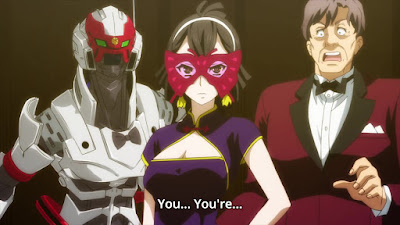Mamoru Hosoda is a strangely difficult director to talk about.
Although just starting his career, he has a mountain of expectations
heaped on him because Studio Ghibli happened to be petering out at
the same time as he got popular. Why else would a relative newcomer
be called “the next Miyazaki” despite his films being entirely
different in message and scope? That's why many were let down by The
Wolf Children, and why I walked into The Boy and the Beast
with lowered expectations. How did it hold up? I enjoyed myself,
but wouldn't call the movie any better than fine.
The story isn't anything groundbreaking. A young boy, Ren, running
away from his foster family encounters a bustling society of
monster-people hiding in the shadows of our own, and gets taken in by
the bear-like Kumatetsu. He's loud, slovenly, and disagreeable, only
taking Ren in so that his lord will consider him a candidate for
succession. Both characters have a lot of growing up to do, and do
it with each other's help. What I realized afterward was that you
can split Ren's journey into six parts, and my enjoyment of each part
differed greatly.
Part one covered the opening, of course, which I thought was very
well done. The first few minutes of exposition dumping was carried
by some fantastic music and CG work, and character introductions were
effective as well. Less effective was the next part which focused
mainly on Ren and Kumatetsu's clashing personalities. They yell at
each other and make lots of funny faces directly into the camera,
which basically lays the foundation for all their later interactions.
The movie's actually quite weak here because not only is this not
funny or charming, neither characters' motivation comes through
strongly at this point. Why are these two shouting at each other
across the table when neither really has a good reason to even sit at
the same table? Too bad, because characters like mild-mannered monk
Soshi and sorta-antagonist Iozen are introduced here, both of which
feel like they'd be more interesting to watch.
Part three I consider to be when Ren and Kumatetsu both get serious
about training, and here things pick up again. Realizing that they
each can learn from the other, their relationship becomes one of
sidelong glances and unspoken words underneath all the bickering.
It's pretty cheesy, but it's the closest to human warmth those two
get. Besides, training montages! Always a good thing.
And then things get weird with a timeskip of about ten years or so.
Without giving too much away, Ren becomes suddenly involved with the
human world again, specifically with a pretty young female student,
with his absentee birth father, and with applying for college. Now
the first one or two plot points I can understand, but all three at
once? Out of the blue? This stretch is all over the place with
ideas, but none of them stick. Kumatetsu then finds out Ren's been
doing things in the human world, gets mad about some part of that for
some reason, and the two predictably separate, leaving Ren to
question his own identity and place in the world.
Just as predictably, he returns to encourage his father figure in
part five, which encompasses Kumatetsu's battle with Iozen for
lordship. This is handled well enough; Hosoda really isn't an action
director, so the fight doesn't put you on the edge of your seat, but
I was engaged enough. Sadly, the sixth and final part rears its ugly
head as the fight ends with the reveal of the true villain, in
a shocking turn of events only those with eyes saw coming.
Mamoru Hosoda's typically uplifting messages are found as expected
in the climax, but boy do you have to dig through a pile to reach
them. Plot holes abound as the human world is needlessly brought
into the conflict; the villain really has no reason to rampage there
for one thing. Also, the laws of passage between realms is casually
violated by a group of low-ranking beastmen for the sake of a single
line of exposition we already knew. References to Moby Dick,
already a bit forced in this film, are hammered in way too hard. The
CG looks good, but is overused to the point of distraction. The
final battle's pace just drags. And as Ren's
not-really-girlfriend clings to him throughout the end, she doesn't
feel like she belongs in any of this.
In summary, I enjoyed The Boy and the Beast while viewing it,
but afterwards the flaws jumped out at me more than the good parts.
I've heard Hosoda lacked one of his usual writers for this film, and
I believe it; lots of meaningless plot points could have been cut
from the second half for a more coherent feel, and personalities
should have been shuffled a bit so side characters weren't more fun
to watch than the main duo. This was essentially a clumsier version
of Hosoda's previous works, and he'll have to either make
better-constructed movies about the importance of family in the
future, or do something completely different to hold our collective
interest.
You're one of the last well-known directors of original anime films.
We're all rooting for you, man.





















